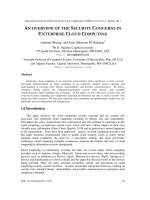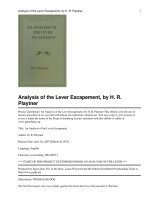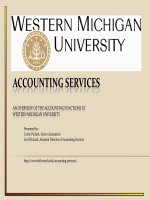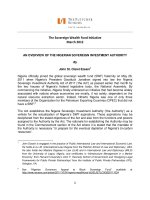An Overview of the Computer System pdf
Bạn đang xem bản rút gọn của tài liệu. Xem và tải ngay bản đầy đủ của tài liệu tại đây (1.37 MB, 29 trang )
An Overview of the
Computer System
le s s o n 1
This lesson includes the following sections:
•
The Parts of a Computer System
•
Looking Inside the Machine
•
Software: Bringing the Machine to Life
The Parts of a Computer System
•
What is a Computer?
•
Hardware
•
Software
•
Data
•
Users
•
A computer can convert data into information that is
useful to people.
•
A complete computer system includes four distinct
parts:
Hardware
Software
Data
User
The Parts of a Computer System
- What is a Computer?
A computer is an electronic device used to process data.
•
A computer's hardware consists of electronic
devices; the parts you can see and touch.
•
The term "device" refers to any piece of hardware
used by the computer, such as a keyboard, monitor,
modem, mouse, etc.
The Parts of a Computer System - Hardware
•
Software – also called programs – consists of
organized sets of instructions for controlling the
computer.
•
Some programs exist for the computer's use, to help
it manage its own tasks and devices.
•
Other programs exist for the user, and enable the
computer to perform tasks for you, such as creating
documents.
The Parts of a Computer System - Software
•
Data consists of raw facts, which the computer can
manipulate and process into information that is
useful to people.
•
Computerized data is digital, meaning that it has
been reduced to digits, or numbers. The computer
stores and reads all data as numbers.
•
Although computers use data in digital form, they
convert data into forms that people can
understand, such as text, numerals, sounds, and
images.
The Parts of a Computer System - Data
Ten different
symbols in
the decimal
system
Numbers above 9
use more than 1 digit
•
People are the computer's operators, or users.
•
Some types of computers can operate without
much intervention from people, but personal
computers are designed specifically for use by
people.
The Parts of a Computer System – Users
Looking Inside the Machine
•
Types of Hardware
•
The CPU
•
Memory
•
How Memory is Measured
•
Input and Output Devices
•
Storage Devices
A computer's hardware devices are categorized as
follows:
•
Processor
•
Memory
•
Input and output (I/O) devices
•
Storage devices
Looking Inside the Machine –
Types of Hardware
01001010
01101010
01101111
10001111
10000000
Looking Inside the Machine - The CPU
The procedure that
transforms raw data
into useful
information is called
processing. This
function is divided
between the
computer's processor
and memory.
The processor
is also called
the central
processing
unit (CPU). It
manages all
devices and
performs the
actual
processing of
data.
The CPU consists of one or more chips attached to the
computer's main circuit board (the motherboard).
•
Memory also consists of chips attached to the
motherboard.
•
Memory holds data and program instructions as
the CPU works with them. This memory is called
Random Access Memory (RAM).
•
The CPU can find any piece of data
in RAM, when it needs it for processing.
•
RAM is volatile, meaning it holds data
only when the power is on. When the power
is off, RAM's contents are lost.
Looking Inside the Machine - Memory
•
The smallest usable unit of measure for memory is
the byte – the amount of memory required to hold
one character, like the letter A or the numeral 2.
•
Computers work with larger chunks of data,
measured in multiple bytes, as shown below:
Unit Approx. Value Actual Value
(bytes) (bytes)
Kilobyte (KB) 1,000 1,024
Megabyte (MB) 1,000,000 1,048,576
Gigabyte (GB) 1,000,000,000 1,073,741,824
Terabyte (TB) 1,000,000,000,000 1,099,511,627,776
Looking Inside the Machine
– How Memory is Measured
•
Input devices accept data and instructions from the
user or from another computer system. The keyboard
and mouse are examples of input devices.
•
Output devices return processed data back to the
user or to another computer system. The printer and
monitor are examples.
•
Communications devices (such as modems and
network interface cards) perform both input and
output, allowing computers to share information.
Looking Inside the Machine –
Input and Output Devices
•
Storage devices hold data not currently being used
by the CPU. Data is commonly stored on a magnetic
or optical disk. Each type uses a special medium for
storing data on its surface.
•
A disk drive is a device that reads data from and
writes data to a disk. Most new computers feature a
floppy disk drive, a hard disk drive, and an optical
disk drive.
•
The most common optical storage devices are CD-
ROM and DVD-ROM drives.
Looking Inside the Machine - Storage Devices
Software: Bringing the Machine to Life
•
What is Software?
•
System Software
•
Application Software
•
Software is a set of electronic instructions that tells
the computer how to do certain tasks. A set of
instructions is often called a program.
•
When a computer is using a particular program, it is
said to be running or executing the program.
•
The two most common types of programs are system
software and application software.
Bringing the Machine to Life –
What is Software?
•
System software exists primarily for the computer
itself, to help the computer perform specific
functions.
•
One major type of system software is the operating
system (OS). All computers require an operating
system.
•
The OS tells the computer how to interact with the
user and its own devices.
•
Common operating systems include Windows, the
Macintosh OS, OS/2, and UNIX .
Bringing the Machine to Life –
System Software









